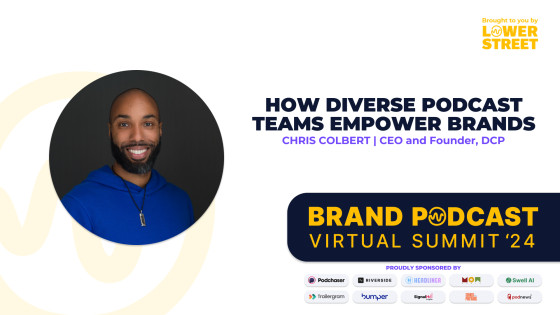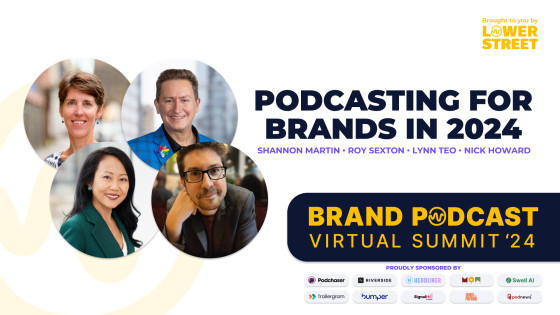Authority: Execution Isn't Enough. It's Time to Rethink Good Podcasts.
Contents

There are two main things that I believe determine whether or not content is good.
One is execution, and one is creativity.
For most of my career, I relied on the former.
And just to be clear, when I say creativity, I mean foundationally creative, I mean the reinventing the wheel kind of creativity.
This Is What I Mean
Let me give an analogy. Movies. We’ve all read Save The Cat, right? Probably not actually. In fact, if I’m being honest, I didn’t even finish it. But let’s talk about it anyway.
Save The Cat is a book about screenwriting that basically handed writers the script formula that we see in nearly every movie that hits the big screen. It’s not really relevant to cover what that formula is, so I won’t.
What is important is that within that formula, there are still good and bad movies. Whether or not a movie is good largely depends on execution. It also does depend on creativity, as every piece of content or art does, but not foundational creativity.
Foundational creativity is a movie like The Blair Witch Project. A movie that rejected the typical screenwriting tropes and did something completely different. Completely creative.
And it worked.
As I stated at the beginning of this essay (I guess it’s an essay?), for the majority of my career I have relied on execution. I have done what I know works foundationally, and I have given 110% to make things the best quality possible. That’s how I have made content that has stood out.
Here are a few examples.
(Skim this section if you don't care about my personal production history... but I promise there is value in the context.)
When I was in my early 20s I watched a lot of a specific kind of content on YouTube. I liked the format a lot, but I thought the execution in the niche overall was just fine. So I said to myself, “I can do that, but better.” And I did. My first video got 1 million views, and the rest ranged from 5k-400. I had roughly 15k subscribers. But it was a lot of work. Eventually, it was too much time that I didn’t have and I ended the project.
This example is a bit different. When I was in news radio, I was fascinated with The Daily. I so badly wanted to move away from traditional audio journalism and get into podcasting. Eventually, I was given full creative control at a local news outlet to develop a daily news podcast. I then proceeded to rip off The Daily. Again, strong execution. The podcast was made for a city of 90k people, and I raked in about 30k downloads a month. But, for such a small outlet, it was killing me. I burned myself out.
And here is my last example, a more sustainable one. Before I became Head of Authority at Lower Street, I worked my way up as a producer. At Lower Street, we have leaned heavily into the narrated interview format. That’s because it works. They work because we kill it with execution. As producers, we put in a hell of a lot of effort to bring our shows to life, and make them sound better than 99% of podcasts out there. Yes, I’m boasting, but I truly believe that. It’s why we’re the international lead in branded podcasting.
But again, we hit a snag. Time is money. Also, time is time. Both of those things are incredibly valuable. Not everyone has those in abundance, especially founders and business leaders.
And This Is Why I’m Changing
Here we hit my new perspective on content.
About 7 or so months ago, I was assigned a new client. This client was Sam Parr. Sam wanted to make a podcast that felt top tier production wise and had a killer hook to it. From that came MoneyWise, a show that has skyrocketed in popularity and receives overwhelmingly high praise.
Following its success my CEO, Harry Morton, came to me with an idea. He basically said this: There are so many business leaders out there who want a show like MoneyWise. I know that MoneyWise takes you a lot of work, I want to think about how we can make shows like it with a significant reduction in time.
A challenge. I like those.
So I started thinking.
My first approach was to find ways to use AI tools and updated processes to find efficiencies in our current production method. I developed a format and a system that I thought was sure to work. But then I had an epiphany.
I was basically just looking for ways to do the same thing we have always done while scaling back our execution. That was not the answer.
Instead, I realized, in order for us to meet the same production quality that Lower Street (and myself personally) have set our standards to, I needed to be more creative on the foundational level.
THAT was the answer.
So Here’s What I did
This is a very long way for me to say this: in order to create a product that can uphold the Lower Street quality standard while saving significant resources, we need to be more creative with the entire foundation of our show formats.
So I looked back at the past 8 years of Lower Street shows with that in mind and came up with a novel, modern internet forward approach that stripped the unnecessary bloat and focuses on what matters most: Standing out and being time sustainable.
The approach: I identified the most time-consuming parts of production and set guidelines to avoid them, pushing Authority producers to focus on creativity. This lets us create unique, standout shows with full production power, world-class quality, ultra-affordable rates, and no compromises.
This is Authority.
Let’s make some cool stuff together,
Jackie Lamport
Head of Authority (what a title, eh?)
P.S - We have also developed ways to create traditional interview shows in this tier, so don’t feel left out if that is truly what’s best for your audience. We have solutions 🙂
Thinking about launching a podcast for your brand?
If you need a hand launching, producing, or promoting your branded podcast, the Lower Street team is here to help. Get in touch for a free consultation.contact us today to get started.
Contact us




